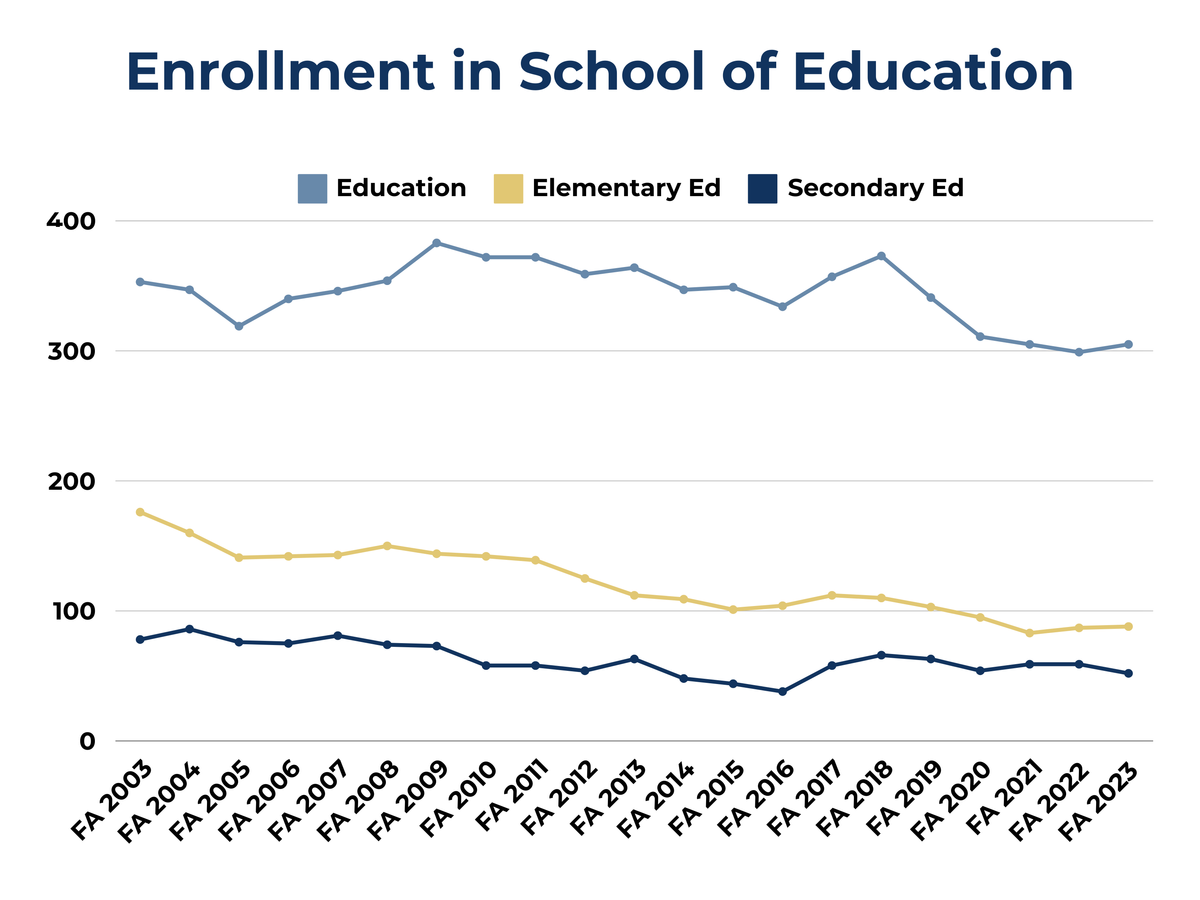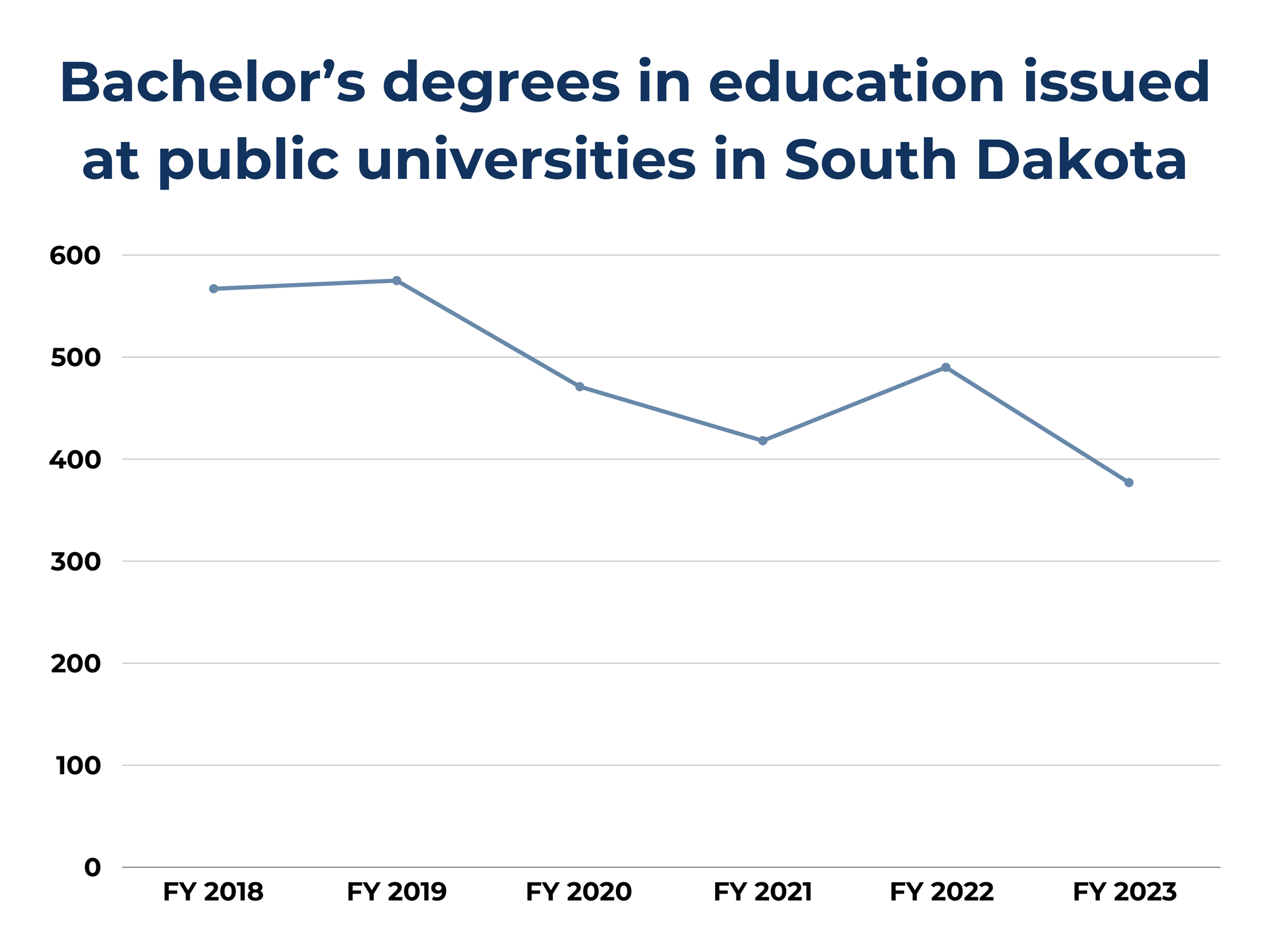School of Education finds hope in students amid national teacher shortages, enrollment declines

Augustana’s Sharon Lust School of Education has witnessed trends of lower enrollment numbers in recent years, like many universities across the country, but it has undertaken several initiatives to help more students become future teachers.
Laurie Daily, the dean of the School of Education, said the education field began to face multiple challenges prior to the pandemic: political polarization, an increase in students facing mental health concerns, more student behavioral challenges, rising costs of living, increasing student loan debt and stagnant teacher pay.
The years following the start of the COVID-19 pandemic, and even prior, have seen nationwide teacher shortages and teacher burnout in addition to fewer education majors.
“I think it’s the conflation of a variety of things that aren’t helping us, you know?” Daily said. “But I think the pandemic affects it. It feels like it made a lot of people’s jobs just harder, including teachers.”
Education professor Brad Uhing said the pandemic accelerated some of the challenges the education field was facing prior to 2020.
“The pandemic changed it completely,” Uhing said. “It took a lot of people out of the profession. Also after the pandemic, fewer students were going into the field of education at the university level. So, yeah, the pandemic was really a critical point, and we’re trying to recover from that still.”
Enrollment declines
According to a 2022 study conducted by the American Association of Colleges for Teacher Education, the annual number of undergraduate education degrees issued reached its peak at 200,000 in the early 1970s.
A 2022 Pew Research Center study found that U.S. higher education institutions issued just over 85,000 bachelor’s degrees in education in the 2019-2020 academic year, the most recent year with available data. Those degrees made up 4% of the more than 2 million total issued degrees that year. That percentage is down by 19% from 2000-2001, when 105,000 graduates took home bachelor’s degrees in education.

The number of undergraduate students attaining degrees in education has declined in South Dakota, too. From fiscal year 2018 to fiscal year 2023, the number of bachelor’s degrees issued in education at public South Dakota universities has dropped from 567 to 377, according to Fact Book data from the South Dakota Board of Regents.
“I think we are actually seeing that impact at Augustana,” Daily said. “We have seen a decrease in the number of people who are wanting to come in.”
Total fall enrollment in Augustana’s School of Education has largely fluctuated over the past 20 years. The school saw declining numbers from fall 2018 to fall 2022. According to data from the registrar, the school’s 10 undergraduate programs had risen by six to a total of 305 enrolled students in fall 2023, still down from a height of 383 in 2009, which had eight programs.
Enrollment in secondary education has decreased by 33% since 2003, and elementary education enrollment numbers have declined from 176 in fall 2003 to 88 in fall 2023.
Nick Jackson, an education instructor at Augustana, said he and his colleagues have noticed smaller class sizes than when they attended the university as students. He said many incoming freshmen even receive negative messages about the profession of teaching.
“I’ll hear many stories from our ed majors about, like, ‘My parents really questioned whether I should do this. Do you really want to teach?’ And trying to steer them into other professions, which is really sad to me,” Jackson said.
The School of Education has experienced enrollment increases in certain fields of study, though. Daily said more students are taking a minor in special education, but fewer are opting for the major.
Special education major numbers have seen ups and downs throughout the past 20 years, reaching a peak of 54 in fall 2015 before gradually declining to 20 students in fall 2023. The number of special education minors has also fluctuated since 2014 but has been on the increase since 2018. In spring 2024, 29 students were taking the minor, compared to spring 2018’s 20.
Additionally, the School of Education has welcomed an increase in students taking one of two newer majors: education studies and special education studies. Daily said the majors are for students who are interested in working with kids in some capacity but perhaps not teaching.
Data from the registrar shows the majors began with a combined enrollment of two students in its first semester in fall 2020. In fall 2023, nine students were enrolled in one of the two majors.
Rather than requiring student teaching, like the usual education majors, the education studies majors take a three-credit internship. If students later decide they want to become teachers, they will have already taken a number of courses required for certification.
“They’re ahead of some of their peers who graduate with unrelated majors who are going into teaching,” Daily said.
However, some education students — like senior Taylor Melton, an elementary education major with an art minor, — said their love for teaching outweighs potential negative characteristics of the field.
“There’s days that you have those students that are like, ‘Wow, you taught me something today,’ and you’re like, ‘Did I?’” Melton said. “That’s a powerful, positive thing, and that definitely keeps me going.”
Junior Laura Murray, an elementary education major, said that as a child her mom often asked her what she was going to do to make the world a better place. For Murray, the answer almost always came back to the roots of society.
“And that’s the kids,” Murray said. “Getting to form their minds to be able to take care of others and teaching them what morals are and how to act in society, that way we can work together and hopefully eventually live in a better place.”
Senior Hanna Beshai, an English, religion and secondary education major who plans to teach English, said she wants to be a teacher in part so she can help create a safe space for students to share their stories.
“I believe that every student has a story to tell,” Beshai said. “And I want to be able to create a space and an environment where they feel that their story is worthy of being told and, of course, create a safe space for those stories to be told.”
Scholarships and new programs
Achieving the education required to fulfill those hopes has become more costly in recent years.
According to a May 2023 Forbes article, the average cost to attend a four-year institution full time had increased from 1980 by 180% in the 2019-2020 school year. The average price for tuition, fees, room and board came in at $28,775 that year. The National Center for Education Statistics shows Augustana’s total cost of attendance in 2019-2020 as $47,497 but $24,322 for the average net price after aid and scholarships.
With the cost of higher education rising and teacher pay remaining rather stagnant, the School of Education is set to offer several scholarship opportunities for students in the coming years.
Augustana currently participates in the TEACH Grant, for example, which is a federal student aid program. The grant allocates up to $4,000 annually to students who undertake course work necessary to begin a career in teaching.
The School of Education also established a partnership with Educators Rising this fall, a national organization that helps high school students gain hands-on teaching experience and develop necessary skills.
Daily said about 120 Educators Rising students came to campus in November, and the admissions office offered $2,000 annually for students who attended the event and enrolled at Augustana for the next academic year.
Additionally, the School of Education has been working with the Teacher Pathways program in the Sioux Falls School District, with plans to host high school students on campus.
For graduate students, the school offers legacy scholarships for Augustana alumni to return for graduate programs, Daily said.
“I do think we have some scholarships but not enough,” Daily said. “I’d love to see us do more in the area of scholarships.”
Over the last decade, Augustana has also kickstarted a string of initiatives in the field of education. Since 2017, the university has added master’s programs in special education: early childhood and K-12; special education: applied behavior analysis; counseling, social work and a learner-designed concentration to the graduate education program.
Daily said the ABA program has been especially popular.
“I mean, we were anticipating we were only going to launch one cohort a year for that program,” Daily said. “And the second semester, we added a second cohort.”
At the certificate level, the School of Education has added focuses in play therapy, addiction counseling and prevention and integrated behavioral health, with more to follow after the upcoming academic year.
Hope for the future
As teacher shortages continue and enrollment numbers waiver nationwide, Daily said she sees hope for the future of education in watching Augustana students.
“Teaching is not a field where it’s highly compensated and people aren’t paid for the value they carry, truly,” Daily said. “It’s a field that brings deep satisfaction and joy and that is really an impactful vocation.”
Jackson, who has taught every level from third grade through college and has taught in Pennsylvania, Colorado and South Dakota, said the teachers he comes across are inspiring.
“Ninety-five percent of the teachers that we encounter and come across are incredible,” Jackson said. “They’re really great, and they’re really inspired, and they’re trying their best, and they’re doing all these things. And again, we don’t always hear about those teachers.”
In light of some non-optimistic statistics, many education students at Augustana feel strong in their choices to become the country’s future educators.
“There’s something about being able to be there for the kids and also being able to be a mentor and a friend and a supporter,” Murray said.
For Melton, teaching provides the opportunity to leave lasting impacts on students.
“Growing up, I was the quiet student, the one that wasn’t really noticed and stuff, and, like, the shy one,” Melton said. “And then I learned that the relationships that teachers can create with a student, especially those types of students, are so powerful and positive that I want to be that model to those students.”
Beshai said her students have taught her about the world and herself.
“And they remind me every single day of what it means to be human,” Beshai said. “And that is a gift that you can't pass up and that you can't learn in a textbook. You have to experience it.”



